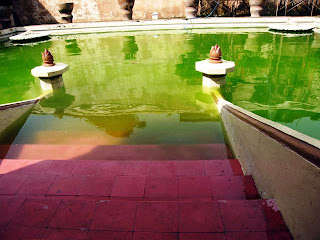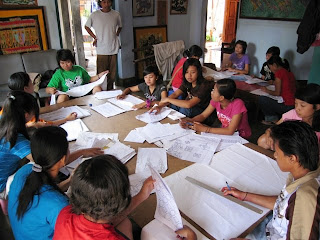Indonesia Trip '08 – Day 07 : Ngasem Bird Market, Water Castle and Underground Mosque - Jogja
We initially had a full day’s worth of sight seeing planned for our last day at Jogja. We were suppose to visit the Kraton in the morning but we did not know that it only opened at 9:30 am for visitors when we left the homestay with our driver at 8am. Since it was still early, we stopped for a short impromptu walk through the Ngasem Bird Market which we were suppose to go to later that afternoon. Given the early hour in the day, the market was still set up as a normal market selling daily provisions for the locals instead of just a tourist attraction. We were able to observe the local produce being sold as well as seeing how they setup the live animal section of the market. While the market was more popularly known for it’s myriad of live birds, there were also other animals for sale (as pets from what I was able to find out) at the market. There was even a reptile and snake section of the market that there was no way anyone can make me go near!
(Scenes from Ngasem Bird Market)
As we were walking amongst the animals and people at the market, a local came up to us and offered to guide us through the market. It was easy for them to pick us out since we were the only tourists in the area that early in the morning. Since we already had seen what we wanted to see in the market, we initially declined his offer but he then offered to take us to the Water Castle which was close by. We had to mull it over for a bit since we did have that attraction planned for later in the afternoon but eventually decided to skip the rest of the tour this afternoon and rest up at the homestay instead. Knowing well that accepting this offer might involve some stops at souvenir shops, we decided to chance it nevertheless. In our minds, we just hoped that our wallets would not be slaughtered to much by it.
(Animals for sale at Ngasem Bird Market)
Once we agreed, the local guided us through the village pathways that was built in what was the old Palace gardens surrounding the Water Castle. The “Taman Sari” as it was called back then, as was told to us, was connect to the Kraton complex via a series of canals by which the Sultan would use to travel by royal boat to his Water Castle. The moats and canals were no longer there and instead houses belonging to the descendents of the people who worked in the Kraton took their place. As we walked though the narrow paths, we got a glimpse of how the locals lived their daily lives. It was quite an intimate experience since we were basically able to look into the windows of their homes while we passed them. We then soon arrived at the underground tunnel that connected Taman Sari with the Water Castle which was previously used by the royal concubines to travel from the palace complex under the protection of watchful guards. It was definitely cooler in the tunnel and we could easily picture the procession of maidens down the length of the tunnel thanks to our guides descriptions of the ceremony.
(The concubine's tunnel to Water Castle)
We soon reached the old wall separating Taman Sari and the Water Castle where the public entrance to the Water Castle was located. Since it was still early, the public entrance was not opened yet so our guide led us through the side paths to the other end of the Water Castle. Unlike the public entrance where tourists were charged a fee to enter the complex, we used the local entrance instead where the entrance fee was not collected. From that entrance, we used another entrance to reach the main bathing pool where the concubines would come and bathe in under the watchful eye of the Sultan who would be observing them from the nearby viewing platform. When the Sultan made his selection of which concubine would accompany him, the bathing beauty would be brought into the Sultan’s private bathing area to bathe with the Sultan before both retiring to the adjoining resting place where things would move further intimately.
(Water Castle Main Entrance Interior)
(Concubine's pool at Water Castle)
We were told that the pools were close to 8 feet deep so I guess one of the requirement of being the Sultan’s concubine back then was the ability to swim! The pools that previously would be filled with clear water were now filled with greenish rain water which fortunately did not smell like stagnant water. Since I could see some restoration and cleaning efforts in progress in the area, I’m guessing that they would be able to return the Water Castle to it’s former glory with the original clear pools of water. In the mean time, the green pools actually made a very striking subject for our cameras that were clicking away from the moment that we arrived.
(Sultan's private pools at Water Castle)
Before leaving the Water Castle area, we were led to another shop selling batik art produced by the people who lived in the area. Unlike the one that we went to on our first night at Jogja, the prices here were much cheaper and I eventually got another piece at this shop to hang on my wall at home. If you are ever in Jogja and want to buy batik pieces for wall hangings or framing, wait till you get to batik studio at the Water Castle grounds before you buy them. You’ll definitely be more impressed by the selection and prices of the pieces there.
After the shopping detour, we proceeded again through the narrow and winding paths that went through the surrounding village. I got separated again with the rest of the group who walked ahead while I was talking to our guide but thanks to expensive roaming charges on my mobile, I was able to find out where they were and proceeded to their location. On the way, I chanced on a group of children in front of a non descript house. Curious about it, I asked the guide who was with me and found out that they were there to learn the art of making batik. I asked if I could pop in and see the class in progress which the teacher who were teaching the class graciously allowed. I even got to sit in among the students to see them learn the patterns that they would use in their batik pieces which they were very happy to show me. I wished that I had a longer time to spend with them as it was definitely a unique experience for me but I had to catch up with the rest of the group.
After the shopping detour, we proceeded again through the narrow and winding paths that went through the surrounding village. I got separated again with the rest of the group who walked ahead while I was talking to our guide but thanks to expensive roaming charges on my mobile, I was able to find out where they were and proceeded to their location. On the way, I chanced on a group of children in front of a non descript house. Curious about it, I asked the guide who was with me and found out that they were there to learn the art of making batik. I asked if I could pop in and see the class in progress which the teacher who were teaching the class graciously allowed. I even got to sit in among the students to see them learn the patterns that they would use in their batik pieces which they were very happy to show me. I wished that I had a longer time to spend with them as it was definitely a unique experience for me but I had to catch up with the rest of the group.
(Narrow pathway through village at Taman Sari - Jogja)
(Batik art class in session at Taman Sari - Jogja)
After the impromptu lesson in batik drawing with the children of the village, we reached the underground mosque where the rest of my traveling companions were. The underground mosque was actually part of a bigger mosque where the upper levels were used by the males and the underground section was for females only. Built using carved stones, the under ground mosque was also used as shelter for the people of the surrounding areas in times of trouble or wars. The roof that used to be overhead the stone stairs leading down to the underground mosques was no longer there and while it was kept clean, the underground mosque didn’t seem to be a place where many tourists would stop by. It was still a good place to get temporary respite from the heat outside before proceeding with our journey.
(Underground Mosque stairs and interior, Taman Sari - Jogja)
The underground mosque was our last destination on our walkabout and we soon reached the entrance of the Ngasem Bird Market. We thanked our guide for his time and gave him a 30,000 Rph tip before walking back to the spot where our driver was waiting for us. In hind sight it was quite a gamble for us to take up that offer from a totally stranger but in the end everything ended well and furthermore we got to experience a different side of Jogja which we would probably may be exposed to if we took the official guided tour. This walkabout was particularly memorable for me due to the local flavor that I was able to absorbed walking through the villages as well as the opportuinity to interact with the locals directly.
Some gambles do apparently pay off handsomely in way we would never foresee.
Some gambles do apparently pay off handsomely in way we would never foresee.





























No comments:
Post a Comment